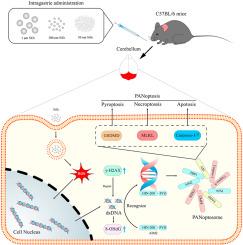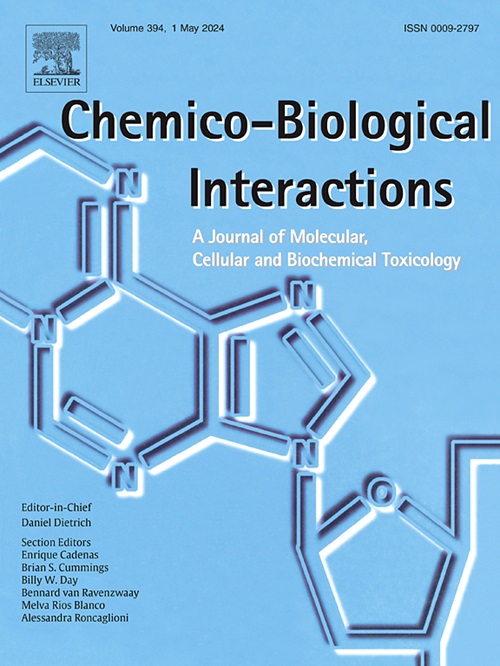Silicon dioxide particles induce DNA oxidative damage activating the AIM2-mediated PANoptosis in mice cerebellum
IF 5.4
2区 医学
Q1 BIOCHEMISTRY & MOLECULAR BIOLOGY
引用次数: 0
Abstract
Silicon dioxide (SiO2) particles are novel materials with wide-ranging applications across various fields, posing potential neurotoxic effects. This study investigates the toxicological mechanisms of SiO2 particles of different sizes on murine cerebellar tissue and cells. Six-week-old C57BL/6 mice were orally administered SiO2 particles of three sizes (1 μm, 300 nm, 50 nm) for 21 days to establish an in vivo model, and mice cerebellar astrocytes (C8-D1A cells) were cultured in vitro. Indicators of oxidative stress, DNA damage, and the PANoptosis pathway were detected using methods such as immunofluorescence staining, comet assay, western blotting, and qRT-PCR. The results show that SiO2 particles induce oxidative stress leading to DNA oxidative damage. The aberrant DNA is recognized by AIM2 (absent in melanoma 2), which activates the assembly of the PANoptosome complex, subsequently triggering PANoptosis. Furthermore, the extent of damage is inversely correlated with the size of SiO2 particles. This study elucidates the toxicological mechanism of SiO2 particles causing cerebellar damage via PANoptosis, extending research on PANoptosis in neurotoxicology, and aiding in the formulation of stricter safety standards and protective measures to reduce the potential toxic risk of SiO2 particles to humans.

二氧化硅颗粒诱导 DNA 氧化损伤,激活 AIM2 介导的小鼠小脑泛凋亡。
二氧化硅(SiO2)颗粒是一种新型材料,在各个领域都有广泛的应用,具有潜在的神经毒性作用。本研究探讨了不同大小的二氧化硅颗粒对小鼠小脑组织和细胞的毒理机制。给六周大的 C57BL/6 小鼠口服三种尺寸(1 μm、300 nm、50 nm)的 SiO2 粒子 21 天,建立体内模型,并在体外培养小鼠小脑星形胶质细胞(C8-D1A 细胞)。采用免疫荧光染色、彗星试验、Western 印迹和 qRT-PCR 等方法检测氧化应激、DNA 损伤和 PANoptosis 通路的指标。结果表明,二氧化硅颗粒会诱导氧化应激,导致 DNA 氧化损伤。异常 DNA 被 AIM2(黑色素瘤 2 中不存在)识别,从而激活 PANoptosome 复合物的组装,随后引发 PANoptosis。此外,损伤程度与二氧化硅颗粒的大小成反比。这项研究阐明了二氧化硅微粒通过PAN凋亡导致小脑损伤的毒理学机制,拓展了神经毒理学中PAN凋亡的研究,有助于制定更严格的安全标准和保护措施,降低二氧化硅微粒对人类的潜在毒性风险。
本文章由计算机程序翻译,如有差异,请以英文原文为准。
求助全文
约1分钟内获得全文
求助全文
来源期刊
CiteScore
7.70
自引率
3.90%
发文量
410
审稿时长
36 days
期刊介绍:
Chemico-Biological Interactions publishes research reports and review articles that examine the molecular, cellular, and/or biochemical basis of toxicologically relevant outcomes. Special emphasis is placed on toxicological mechanisms associated with interactions between chemicals and biological systems. Outcomes may include all traditional endpoints caused by synthetic or naturally occurring chemicals, both in vivo and in vitro. Endpoints of interest include, but are not limited to carcinogenesis, mutagenesis, respiratory toxicology, neurotoxicology, reproductive and developmental toxicology, and immunotoxicology.

 求助内容:
求助内容: 应助结果提醒方式:
应助结果提醒方式:


